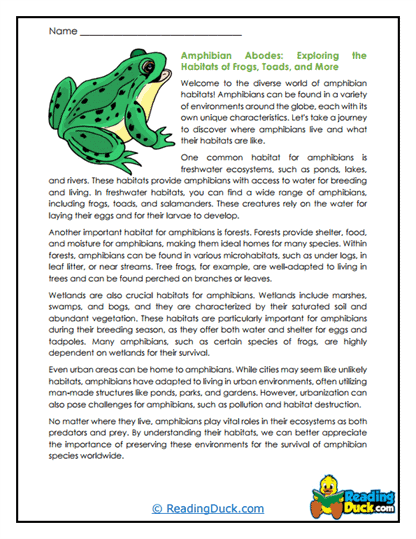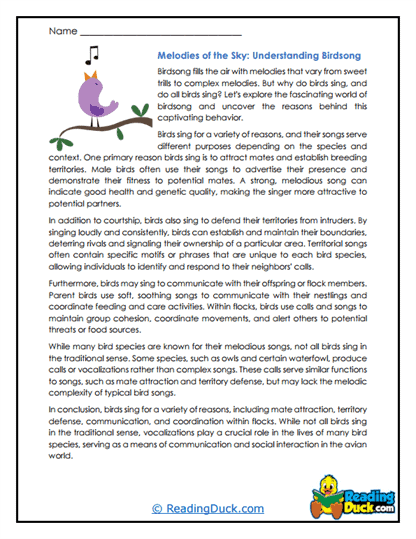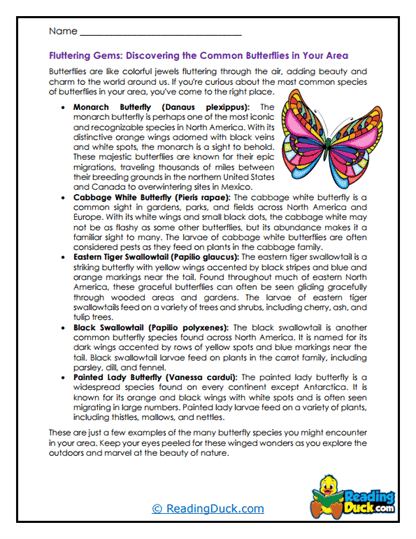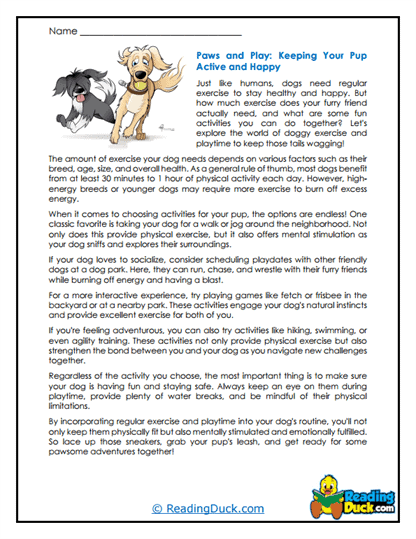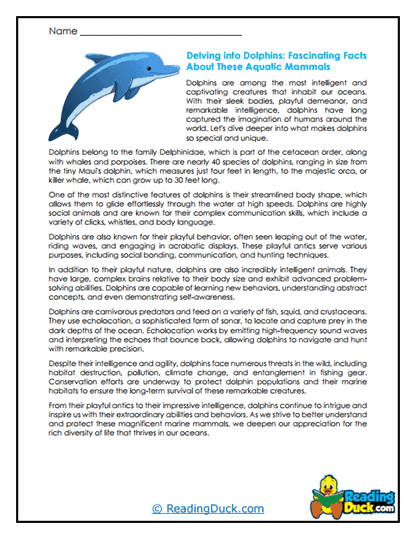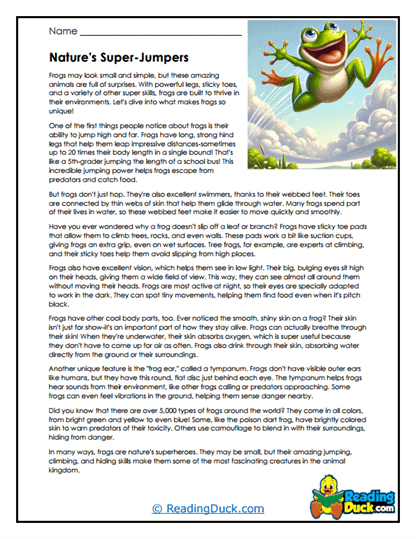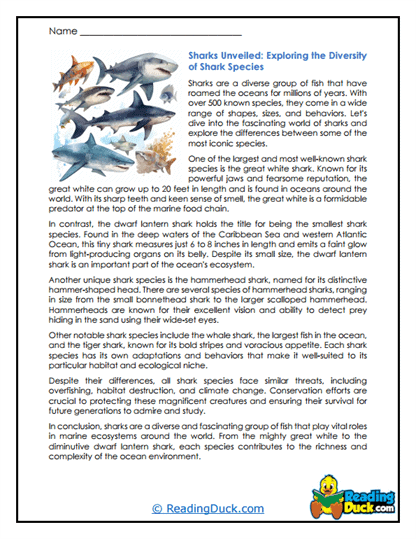Animals Worksheets
About Our Animals Worksheets
Our collection of Animals worksheets offers an engaging and educational exploration into the diverse world of animals, making it a valuable resource under the category of Science: Biology. Animals are a captivating subject that naturally piques the curiosity of students, and these worksheets are designed to deepen their understanding of various animal species and their unique characteristics.
This collection covers a wide range of animal categories, including Amphibians, Birds, Bugs, Butterflies, Dogs, Dolphins, Penguins, Pet Cats, Sharks, and Spiders. Each category contains several worksheet sets, designed to offer a comprehensive learning experience. Every worksheet set features:
- Multiple Choice Questions: These questions assess students' comprehension of the reading passage, ensuring they have grasped the key concepts and details.
- Short Answer Questions: This section encourages students to articulate their understanding in their own words, reinforcing their knowledge and improving their ability to communicate scientific information.
- Open-Ended Questions: These questions prompt students to express their personal thoughts, opinions, and reflections on the material, fostering critical thinking and allowing them to make personal connections with the content.
Each worksheet set is accompanied by a detailed answer key, making it easy for educators and parents to review students' work. The worksheets are provided in PDF format, ensuring they can be easily viewed electronically, downloaded, and printed.
Exploring the Animal Kingdom: An Introduction to Amphibians, Birds, Bugs, and More
When introducing students to the topic of animals, it’s important to convey the incredible diversity of life on Earth. Animals are found in nearly every environment on the planet, from the deepest oceans to the highest mountains, and each species plays a vital role in its ecosystem. This collection of worksheets is organized into specific categories that highlight different groups of animals, allowing students to explore the unique traits and behaviors of each.
Let’s break down the different aspects of this topic:
- Amphibians: Amphibians are a fascinating group of animals that live both in water and on land. This category includes frogs, toads, salamanders, and newts. Amphibians are known for their life cycle, which typically involves metamorphosis from a larval stage to an adult form. They breathe through their skin, making them highly sensitive to environmental changes, which is why they are often seen as indicators of ecosystem health.
- Birds: Birds are a diverse group of feathered animals that are known for their ability to fly, although not all birds are capable of flight. This category includes everything from songbirds to raptors. Birds are found in virtually every habitat on Earth and have evolved a wide range of adaptations, such as specialized beaks, talons, and feathers, to survive in different environments. They play crucial roles in ecosystems as pollinators, seed dispersers, and predators.
- Bugs: Bugs, including insects and other arthropods, make up the largest group of animals on Earth. This category explores the incredible variety of bugs, from beetles and butterflies to ants and spiders. Bugs are essential to many ecosystems, serving as pollinators, decomposers, and a food source for other animals. Their complex behaviors and interactions with their environment provide valuable insights into the natural world.
- Butterflies: Butterflies are among the most beloved insects, known for their vibrant colors and graceful flight. This category delves into the life cycle of butterflies, from egg to caterpillar to chrysalis and finally to adult butterfly. Students will learn about the role of butterflies in pollination and their significance as indicators of a healthy environment.
- Dogs: Dogs are one of the most familiar and beloved animals, often referred to as "man’s best friend." This category explores the domestication of dogs, their various breeds, and their roles as companions, working animals, and therapy animals. Understanding dogs’ behavior, communication, and care is essential for anyone who loves these loyal and intelligent animals.
- Dolphins: Dolphins are highly intelligent marine mammals known for their playful behavior and complex social structures. This category examines the different species of dolphins, their habitats, and their remarkable communication skills. Students will also learn about the challenges dolphins face in the wild, including threats from pollution and habitat destruction.
- Penguins: Penguins are flightless birds that are well adapted to life in the cold waters of the Southern Hemisphere. This category covers the different species of penguins, their breeding behaviors, and how they have adapted to their harsh environments. Penguins are an excellent example of how animals evolve specialized traits to survive in specific habitats.
- Pet Cats: Cats are one of the most popular pets worldwide, known for their independence and affectionate nature. This category explores the domestication of cats, their various breeds, and their behavior. Understanding how to care for cats and interpret their body language can help students develop a deeper bond with these fascinating animals.
- Sharks: Sharks are ancient predators that have existed for hundreds of millions of years. This category investigates the different species of sharks, their adaptations for hunting, and their role in marine ecosystems. Students will also learn about the misconceptions surrounding sharks and the importance of conserving these apex predators.
- Spiders: Spiders are arachnids, not insects, and they play a vital role in controlling insect populations. This category covers the anatomy, behavior, and diversity of spiders. Students will learn about the different types of webs spiders create, their hunting techniques, and their importance in ecosystems as both predators and prey.
By exploring these categories, students will gain a comprehensive understanding of the animal kingdom, learning about the characteristics, behaviors, and roles of various species. These worksheets will guide them through the complexities of Biology, sparking curiosity and encouraging them to think critically about the natural world.
How to Use These Worksheets
Integrating our Animals worksheets into a school or homeschool curriculum offers numerous opportunities to enhance students' understanding of Biology. Here are some practical ideas on how educators and parents can effectively use these worksheets in various educational settings:
- Unit-Based Learning: These worksheets can be used as part of a broader unit on Biology or Life Sciences. After introducing students to basic biological concepts such as habitats, food chains, and adaptation, you can delve into specific animal categories, using the worksheets to reinforce and expand upon what they’ve learned. The worksheets can serve as the foundation for discussions, experiments, and further research on animals and their behaviors.
- Classroom Discussions and Group Activities: Encourage students to work in pairs or small groups to discuss the reading passages and answer the questions together. This collaborative approach helps students articulate their thoughts, listen to different perspectives, and deepen their understanding of the material. The open-ended questions, in particular, are excellent for sparking class discussions, where students can share their ideas and engage in debates about the roles animals play in ecosystems and human society.
- Research Projects and Presentations: After completing the worksheets, students can be assigned to research and present on specific animals or groups of animals, such as the life cycle of frogs, the adaptations of birds, or the conservation status of sharks. They can also explore topics like the history of animal domestication, the impact of human activity on wildlife, or the role of insects in agriculture. These projects can culminate in presentations, reports, or creative displays, allowing students to showcase their knowledge and enthusiasm for the subject.
- Multimedia Integration: Pair the worksheets with multimedia resources to create a more immersive learning experience. For example, students can watch documentaries or educational videos on animal behavior, conservation efforts, or specific species before completing the worksheets. This combination of visual and textual learning can cater to different learning styles and reinforce the concepts covered in the worksheets.
- Homework Assignments: The worksheets are ideal for homework assignments, giving students the opportunity to engage with the material independently. The reading passages and questions are designed to be both challenging and accessible, making them perfect for self-directed study. The answer key allows for easy review, helping students to check their understanding and correct any misconceptions.
- Assessment Tools: These worksheets can be used as both formative and summative assessment tools. Teachers can use the multiple-choice and short answer questions to gauge students' understanding of animal biology, while the open-ended questions can assess their ability to think critically and reflect on the material. This balanced approach to assessment ensures that students' knowledge is tested comprehensively.
- Enrichment Activities: For students who show a particular interest in animals, the worksheets can be used as part of an enrichment program or an extracurricular activity. Students can delve deeper into the subject by exploring advanced topics, participating in Biology clubs, or even attending lectures or webinars by experts in the field.
- Field Trips and Observation Activities: Organize a field trip to a local zoo, aquarium, or wildlife reserve where students can observe animals firsthand. Before the trip, use the worksheets to educate students about the animals they will see and what to look for in terms of behavior and adaptations. After the trip, have students complete the worksheets to reflect on their experience and connect it to what they've learned.
- Cross-Curricular Connections: Animals offer rich opportunities for cross-curricular connections with subjects such as geography, environmental science, history, and literature. For example, students can explore the geographical distribution of animals, the environmental impact of human activity on wildlife, the historical significance of animals in different cultures, or the portrayal of animals in literature and mythology. These interdisciplinary connections can enrich students' understanding and demonstrate the relevance of Biology to other fields of study.
By incorporating these Animals worksheets into the curriculum, teachers and parents can provide students with a comprehensive and engaging learning experience. These worksheets are designed to help students explore the diversity of the animal kingdom, develop critical thinking skills, and foster a lifelong curiosity about the natural world. Whether used in the classroom or at home, these resources will inspire students to appreciate the incredible variety of life on Earth and understand the important role animals play in ecosystems and human society.
















